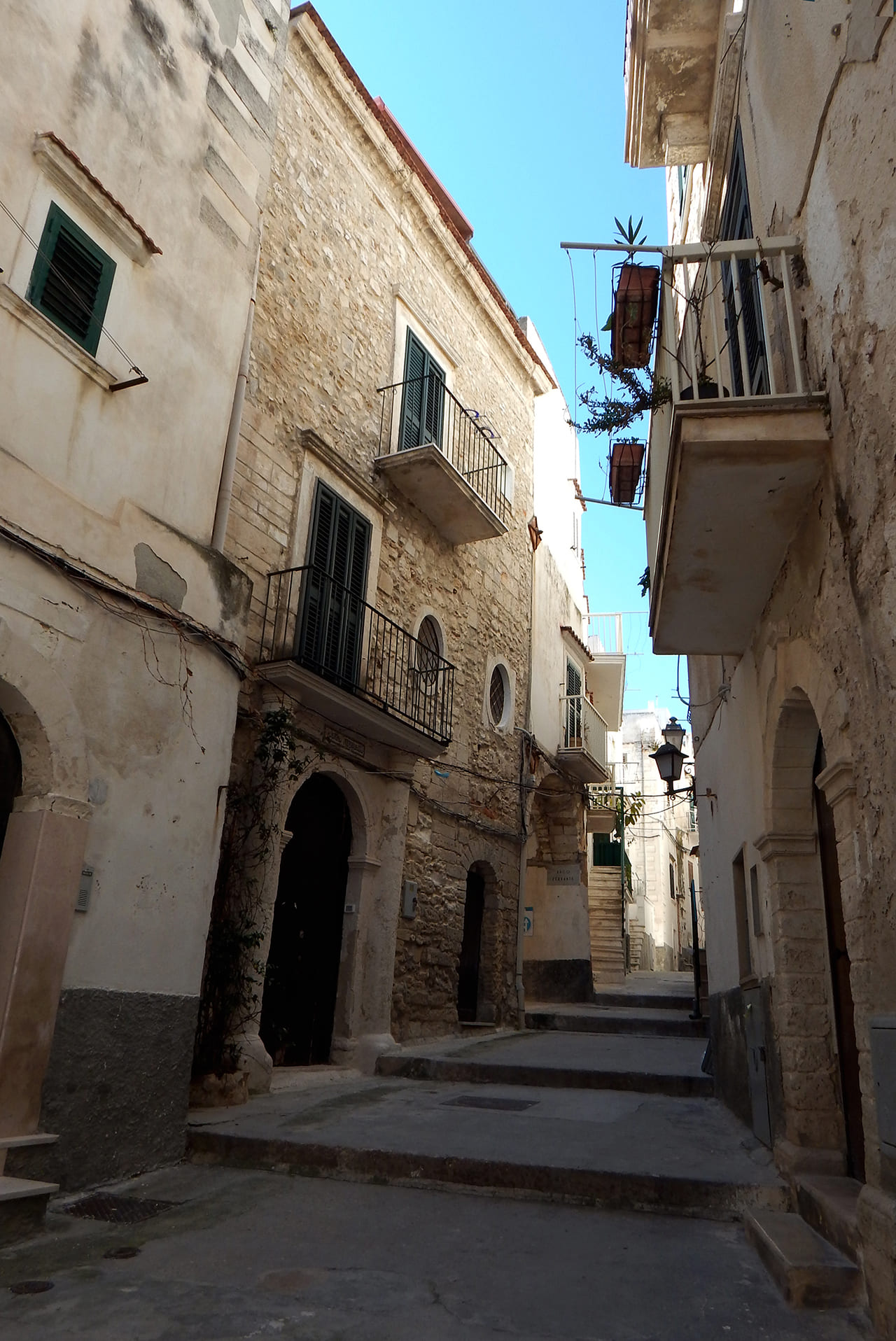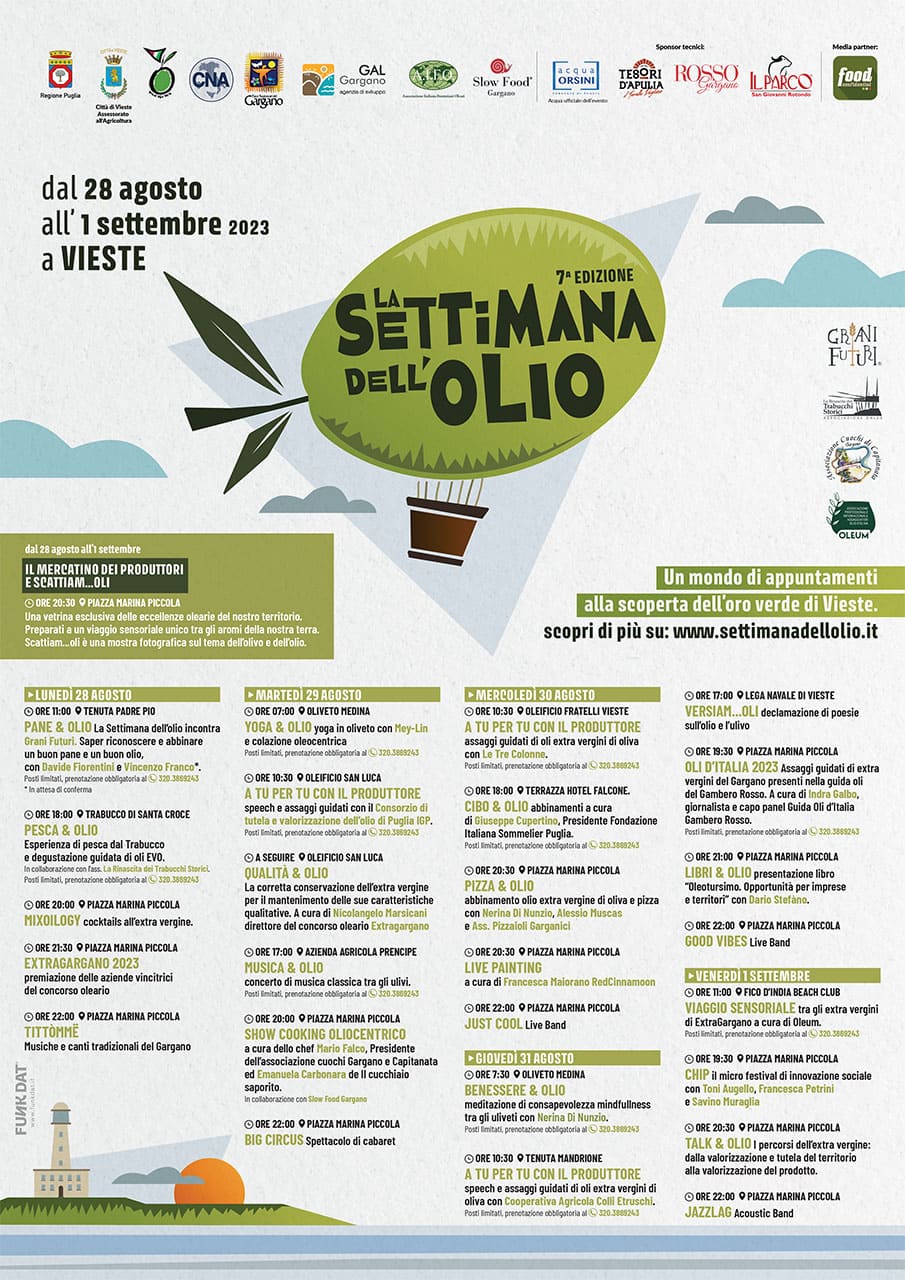La strada è intitolata ad un’importante famiglia viestana che risiedeva nel palazzo con le finestre ovali accanto all’angiporto che immette a via Arco Ferrante. La G di denominazione sicuramente fa riferimento a Giovanni, padre del più famoso Francescantonio. Da sempre questo palazzo viene indicato come il Palazzo del Catapone, o del Capitano in documenti cinquecenteschi, la cui derivazione ha origine dalla corruzione della parola Catapano. Nell’amministrazione bizantina, il Catapano è il governatore di una provincia. In particolare, dal X secolo in poi, il governatore bizantino residente a Bari. Verso la metà dell’XI secolo Ciriaco, ultimo catapano di Puglia, per fermare l’avanzata dei Normanni spostò la sua sede da Bari a Vieste e che nella cruenta battaglia avvenuto in questo territorio, i Bizantini vennero sconfitti e il catapano ucciso dai soldati di Roberto Drengot Questo palazzo in cui dovette risiedere Ciriaco poi passò nelle proprietà di Federico II, individuabile fra quelle iscritte nel “Quaternus excadenciarum Capitanate”. Molto probabilmente l’imperatore ha anche soggiornato in questa palazzo nel 1239 quando accorse a Vieste per rendersi conto personalmente dei danni arrecati dai veneziani alla città. Durante il periodo angioino divenne l’abitazione del Capitano, figura politica nominata per soprintendere a tutte le attività amministrative della città. Durante il periodo fascista, la “G” cambiò in Generale, per onorare l’aeronauta Umberto Nobile, reso famoso per le sue due trasvolate in dirigibile del Polo Nord, per essere poi ripristinata dopo il Secondo Conflitto Mondiale. Questa lunga strada in cima alle scale nei pressi del castello presenta un rilievo circolare cementato che è una delle tante tombe di epoca ellenistica che costituivano una necropoli risalente al IV – III secolo Avanti Cristo. L’urbanizzazione delle Ripe Castello ha distrutto la necropoli e solo alcuni corredi funebri recuperati sono esposti nel museo civico di Vieste.
The street is named to an important local family who lived in the building with oval windows next to the angiporto leading to via Arco Ferrante. The denomination G certainly refers to John, father of the most famous Francescantonio. This palace has always been referred to as the Palace of Catapone, or of the Captain in 16th century documents, whose derivation originates from the corruption of the word Catapano. In the Byzantine administration, the Catapano was the governor of a province. In particular, from the 10th century onwards, the Byzantine governor residing in Bari. In the middle of the 11th century Ciriaco, the last catapan of Puglia, moved its headquarters from Bari to Vieste to stop the advance of the Normans and that in the bloody battle that took place in this territory, the Byzantines were defeated and the catapan killed by the soldiers of Roberto Drengot. This palace in which Ciriaco had to reside then passed into the property of the Emperor Frederick II, identifiable in the document “Quaternus excadenciarum Capitanate.” Most probably the emperor also stayed in this palace in 1239 when he came to Vieste to make sure the damages done by the Venetians to the city. During the Angevin period it became the residence of the Captain, a political figure appointed to supervise all the administrative activities of the city. During the Fascist period, the “G” changed to General, to honor the airman Umberto Nobile, made famous for his two flights in airship of the North Pole, only to be restored after the Second World War. This long road at the top of the stairs near the castle has a circular cemented relief which is one of the many tombs from the Hellenistic era which were a necropolis dating back to the 4th – 3rd century BC. The urbanization of the Ripe Castello destroyed the necropolis and only some recovered funeral kits are on display in the Civic Museum of Vieste.
MULTIMEDIALE
Tra le numerose personalità che hanno reso illustre il nome di Vieste nel tempo vi è anche Francescantonio Nobile, esponente di una delle più importanti famiglie viestane. Figlio di Giannicola e di Maria Antonia Mafrolla, nacque a Vieste il 20 Agosto 1777. Dottore in legge, cultore di storia patria e molto stimato ed apprezzato per la sua cultura, per i suoi studi giuridici e di ingegneria e per la sua attività politica e amministrativa. Fu sindaco di Vieste per diversi anni, amministrando con molta avvedutezza la cosa pubblica e dimostrò la sua abilità quando nel 1806 si insediarono a Vieste le truppe francesi. Egli si prodigò perché la popolazione non avesse a soffrire la presenza dello straniero, provvedendo di persona, alle razioni dei viveri per i soldati e al foraggio dei cavalli. Nel 1817 si recò personalmente dal re per supplicarlo di non sopprimere la diocesi di Vieste ed ottenne che fosse unificata a quella di Manfredonia. Francescantonio Nobile inoltre si distinse anche in politica, s’impegnò molto per l’avvio della bonifica del Pantanello, una zona paludosa che era causa della malaria, e della via rotabile del Gargano. Si adoperò anche con tutti i mezzi per far ritornare i Cappuccini a Vieste, il cui convento era stato soppresso da Gioacchino Murat nel 1809; ordinò l’ampliamento della chiesa di S. Croce, stabili il Camposanto presso la chiesa del Carmine, approntò il regolamento della Polizia amministrativa e fece costruire il mercato per la vendita del pesce. Mori il 20 novembre 1827 all’età di 50 anni.
Fra le sue opere sono da ricordare:
Orazione in morte della principessa Carolina d’Austria
Le leggi di tutti i tempi
Storia di Vieste e del Gargano, inedita andata perduta.
Among the many personalities who have made the name of Vieste famous over time there is also Francescantonio Nobile, member of one of the most important families of Vieste. Son of Giannicola and Maria Antonia Mafrolla, he was born in Vieste on August 20, 1777. He is a doctor of law, a historian of the homeland and is highly esteemed and appreciated for his culture, his legal and engineering studies, and his political and administrative work. He was mayor of Vieste for several years, managing public affairs with great prudence and proved his ability when in 1806 the French troops settled in Vieste. He did his best to ensure that the people did not have to suffer the presence of the stranger, providing in person the rations of food for the soldiers and the fodder for the horses. In 1817 he went personally to the king to beg him not to suppress the diocese of Vieste and obtained that it be united with that of Manfredonia. Francescantonio Nobile also distinguished himself in politics, he worked hard for the start of the reclamation of the Pantanello, a swampy area that was the cause of malaria, and of the Gargano road. He also made every effort to bring the Capuchins back to Vieste, whose convent had been suppressed by Gioacchino Murat in 1809; ordered the enlargement of the church of S. Croce, established the chuechyard near the church of Carmine, prepared the regulations of the administrative police and built the market for the sale of fish. He died on November 20, 1827 at the age of 50.
Among his works are worth mentioning:
“Prayer at the death of Princess Caroline of Austria”
“The Laws of All Time”
“History of Vieste and Gargano”, unpublished and lost way.
Francescantonio Nobile war eine angesehene Persönlichkeit und machte Vieste wirklich wichtig, seine Familie war eine der wichtigsten Familien in Vieste. Er wurde am 20. August 1777 in Vieste als Sohn von Giannicola und Maria Antonia Mafrolla geboren. Er hatte einen Abschluss in Rechtswissenschaften, Experte für Geschichte und Ingenieurwesen und wurde für seine Kultur und seine politische Tätigkeit respektiert. Er war ein brillanter Bürgermeister von Vieste gewesen, besonders 1806, weil er die französischen Truppen verwaltet hatte. Er sorgte dafür, dass die Bevölkerung nicht unter ihrer Anwesenheit litt. Er hat viele öffentliche Arbeiten für die Stadt durchgeführt, eine Trockenlegung, neue Straßen, einen neuen Fischmarkt, und er hat die Polizei der Administration reguliert. Er bemühte sich auch, die Kapuziner nach Vieste zurückzubringen, dessen Kloster 1809 von Gioacchino Murat unterdrückt worden war. Er befahl die Erweiterung der Kirche von S. Croce, errichtete den Friedhof in der Nähe der Kirche von Carmine. 1817 ging er zum König und bat darum, dass die Diözese Vieste nicht annulliert werde, sodass sie mit Manfredonia verschmolzen werde. Er starb am 20. November 1827 im Alter von 50 Jahren.
Unter seinen Werken sind zu erinnern:
Gebet im Tod von Prinzessin Caroline von Österreich (Orazione in morte della principessa Carolina d’Austria)
Die Gesetze aller Zeiten (Le leggi di tutti i tempi)
Geschichte von Vieste und dem Gargano (Storia di Vieste e del Gargano), unveröffentlicht und jetzt verloren.















